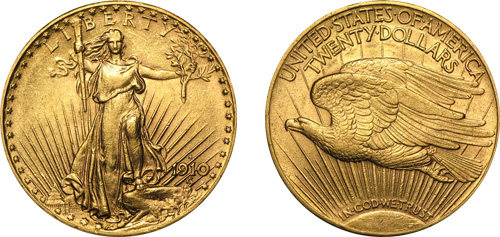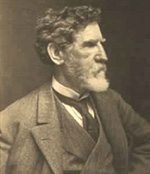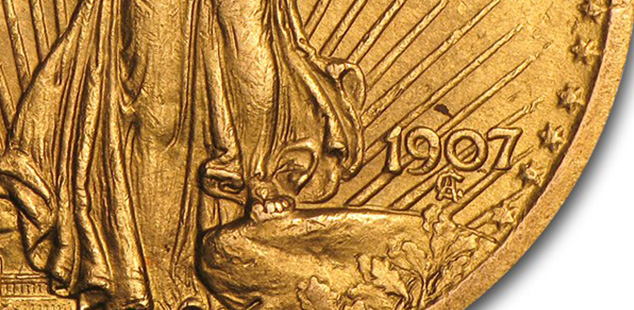
Learn about a little piece of numismatic history with the 1933 Double Eagle gold coin.
History, Value, Availability, and Fun Facts
President Theodore Roosevelt decided early in his presidency that he wanted to bring grace and beauty to American coinage 1, and he did so excellently with the 1933 Double Eagle gold coin. Also known as the Saint-Gaudens Double Eagle, it was designed by the world-renowned sculptor Augustus Saint-Gaudens. Some consider it to be his finest work. Roosevelt, an astute historian, found inspiration in early Greek and Roman coinage, and he wanted the United States to join that pantheon of classical coinage. Today, the extremely rare original 1933 Double Eagle is the most valuable coin in existence.

Considered by many to be one of history’s most beautiful and striking coins, the twenty-dollar Double Eagle high relief gold coin was first struck in in 1907. However, the first $20 Double Eagle coin was originally minted in 1850 as a direct response to the large quantities of gold coming from the California Gold Rush. The coin had such a high value (several hundred dollars in that time), it saw little general circulation and was used primarily in international trade.
Saint-Gaudens: His Historical Destiny
 Saint-Gaudens was one of America’s most revered sculptors when he came to the United States Mint. He was born a decade before the Civil War, and traveled to Europe for training while the nation was still reeling from conflict. The timing of his return allowed him to receive commissions for a number of memorials commemorating the battles and generals of the War Between the States. As a result, he created some of the most famous and critically acclaimed monuments, most still standing.
Saint-Gaudens was one of America’s most revered sculptors when he came to the United States Mint. He was born a decade before the Civil War, and traveled to Europe for training while the nation was still reeling from conflict. The timing of his return allowed him to receive commissions for a number of memorials commemorating the battles and generals of the War Between the States. As a result, he created some of the most famous and critically acclaimed monuments, most still standing.
As his reputation grew, Saint-Gaudens was also selected to design a number of medals and awards, such as the World’s Columbian Exposition. With his reputation, it was only fitting that the U.S. Mint turned to this sculptor to carry out Roosevelt’s dictates after a narrow competition. Nonetheless, officials at the Mint were at odds with the overall concept of an ultra high relief coin. Such coins are not only difficult to produce; they have practical limitations in the field of commerce. Merchants preferred to stack their coins, however, such coins were used frequently in international dealings.
The Birth of an Icon
The generally small circulation of the $20 piece—that was still a handsome sum at the turn of century—made it an ideal first candidate for Saint-Gaudens’ effort to make a high relief coin. The revered design that came from his hands needed 11 strikes to accommodate all the details. This resulted in only an estimated 20 to 25 of the coins being struck in 1905. Acknowledging the practical problems of this coin, a less-detailed high-relief version was introduced in 1906. Over that year and the next, the Mint announced the production of a total of 12,317 pieces. These remain among the most coveted and prized coins from the U.S. Mint by collectors around the globe.

Finally, in 1907, the United States Mint turned to a modified version of the design in normal relief, and produced this coin until 1933. However, the beauty of the Saint-Gaudens Double Eagle was long-lasting; it was the coin design selected for the obverse of the 1986 American Gold Double Eagle bullion coin produced by the U.S. Mint. This modern version of a classically beautiful and valuable coin allows collectors to own and admire a reasonably affordable rendition of the great Saint-Gaudens Double Eagle.
Partly due to his contribution to numismatics and the fulfillment of Roosevelt’s dream, Saint-Gaudens was included in a 1940 series of Famous Americans produced by the U.S. Post Office.
Availability of 1933 Double Eagles Today
The years 1933–1935 were a watershed period for American gold coinage and the tradition of buying gold. While the first president gave us our most treasured gold coin, the second Roosevelt made decisions that saw many millions of U.S. gold coins melted into bullion, most notably the 1933 federal order to recall all gold.
Two 1933 Double Eagle coins were turned over to the Smithsonian and from 8 to 20 other specimens have turned up from time to time. Even King Farouk of Egypt possessed one via a special U.S. Export license. At the same time, the Secret Service has seized and melted the coins when they become known. Many collectors have dreamed of finding one in some foreign bank vault.
Fun Facts about the Saint-Gaudens Double Eagle
As with all treasured works of arts and valuable artifacts, the romance and allure of the Double Eagle includes its own little-known facts. They include:
- When the first Double Eagle was struck in California in 1850, paper money was illegal to use in the newly recognized state.
- Tragically, the artist never saw the final version of his work. He worked on the coin’s obverse and reverse while in failing health. He passed away in 1907 before the designs went into coin production.
- One of the original Saint-Gaudens Double Eagles sold at auction in 2005 for $2,900,000.
- The only 1933 Double Eagle known to be in private hands sold in 2002 for $7,590,020 2 —of which the government claimed 50 percent.
- The chief engraver of the U.S. Mint, Charles Barber 3, had a contentious relationship with Saint-Gaudens. He got his victory by leading the redesign to accommodate only one strike for minting.
- However, the final victory on this prestigious coin’s design went to Congress. Barber’s version left off “In God We Trust,” and a law was passed to make it a part of the final design.
- The Supreme Court has been involved in decade-long battle over the ownership of ten 1933 Double Eagles owned originally by a Philadelphia jeweler.
Do you share the love of such rare coins and the special attraction of gold? If so, you will find ways to indulge that interest while making sound economic investments in your precious metals IRA via the experts at Scottsdale Bullion & Coin.
Additional Sources:
1 – http://www.usmint.gov/mint_programs/ultrahigh/?action=History
2 – http://saintgaudensdoubleeagle.com/1933-saint-gaudens-double-eagle/
3 – http://americanhistory.si.edu/numismatics/doubleea/doubleea.htm

